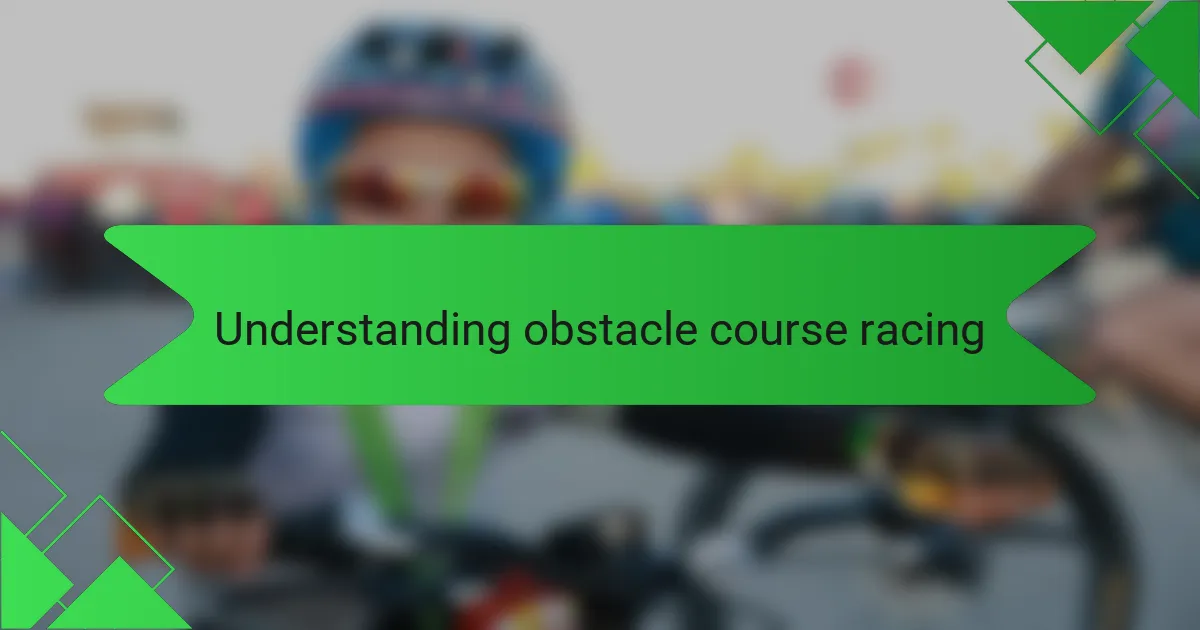Key takeaways
- Obstacle course racing (OCR) emphasizes mental and physical challenges, requiring endurance, strength, and agility for diverse obstacles.
- WOD Nation’s personalized training approach helps participants focus on individual strengths and weaknesses, enhancing goal-setting and progress tracking.
- Physical preparation involves a balanced mix of strength exercises, endurance training, and listening to one’s body for effective recovery.
- Race day navigation is facilitated by clear signage and the importance of maintaining a calm mindset amidst excitement and nerves.

Understanding Obstacle Course Racing
Obstacle course racing, or OCR, combines running with challenging physical obstacles. From my experience, it’s as much a test of mental grit as it is of physical strength. Each race pushes you out of your comfort zone, and overcoming those hurdles gives an unmatched sense of achievement.
What makes OCR unique is the variety of obstacles—from climbing walls to mud crawls—that demand different skills. I’ve found that preparing for these requires a balanced approach, focusing on endurance, strength, and coordination. It’s this diversity that keeps me hooked, always excited for the next challenge.
| Aspect | Obstacle Course Racing |
|---|---|
| Focus | Combination of running and physical obstacles |
| Skills Required | Endurance, strength, agility, and mental toughness |
| Experience | Challenging but rewarding, pushing personal limits |
| Training | Varied workouts balancing different fitness elements |

Introduction to WOD Nation Planning
WOD Nation’s obstacle planning system impressed me right from the start because it brought structure to the chaos of race prep. Having tackled several obstacle courses before, I found their approach really helped me break down complex obstacles into manageable training goals. This method made me feel more confident rather than overwhelmed.
What stood out most was how WOD Nation customized obstacle strategies based on my unique strengths and weaknesses. Instead of generic drills, they focused on what I personally needed to improve, which made each training session feel purposeful and motivating.
- Tailored obstacle-specific training plans
- Step-by-step progression for skill mastery
- Integration of strength and endurance exercises
- Flexibility to adjust based on fitness levels
- Regular tracking of progress and tweaks to the plan

Setting Goals for WOD Nation Obstacles
Setting clear goals for each WOD Nation obstacle was a game-changer for me. I remember feeling unsure how to tackle certain challenges until I identified exactly what I needed to improve—was it grip strength, balance, or explosive power? Pinpointing these areas gave me a roadmap that kept me focused and motivated during training.
Sometimes I wondered, how ambitious should my goals be? WOD Nation’s approach helped me strike the right balance—setting targets that were challenging but achievable. This way, I avoided frustration and actually saw progress week by week, which felt incredibly rewarding.
What I appreciated most was breaking big obstacles into smaller milestones. Instead of fixating on completing an entire obstacle perfectly, I celebrated success in mastering individual skills first. That mindset not only eased my mental load but made each training session feel like a step closer to race day triumph.

Preparing Physically for WOD Nation
Preparing physically for WOD Nation demanded a level of discipline I hadn’t anticipated. I found myself prioritizing targeted strength exercises, like pull-ups and grip work, because I knew these were crucial for obstacles involving hanging or climbing. Have you ever been surprised by how specific muscles can fatigue during a race? That was definitely my experience.
Endurance was another pillar I focused on. Instead of endless running, I mixed in shorter sprints and interval training to simulate the bursts of energy needed between obstacles. This variety kept me engaged and noticeably improved my stamina, which made the race feel less punishing.
What truly made a difference was listening to my body. I learned to balance pushing myself with adequate recovery, adjusting workouts when I felt worn down. This personal tuning of my physical preparation meant I arrived at the event feeling strong but not burnt out—ready to tackle whatever the course threw at me.

Navigating WOD Nation on Race Day
Navigating WOD Nation on race day was surprisingly straightforward, though the energy buzzing around the starting line added a mix of excitement and nerves. I found that the clear signage and helpful volunteers made it easy to find my way through the course without losing focus. Still, keeping a calm mindset amidst the chaos was key—I reminded myself to enjoy the challenge rather than rush through it.
| Aspect | My Experience |
|---|---|
| Course Navigation | Clear signage and friendly volunteers helped me stay on track without confusion. |
| Race Day Atmosphere | The energetic crowd heightened my adrenaline but required mental focus to stay calm. |
| Pre-Race Preparation | Arriving early gave me time to soak in the vibe and mentally prepare for the obstacles. |
| Challenges Faced | Balancing excitement with composure was difficult but rewarding once I settled in. |

Lessons Learned from WOD Nation
One key lesson I took away from WOD Nation is the importance of strategic obstacle planning instead of just brute force. I remember facing a tricky wall and realizing that pacing and timing made all the difference, not just jumping repeatedly. This taught me to respect the course’s design and plan my moves carefully.
Another insight was how WOD Nation’s approach increased my mental toughness. Overcoming each obstacle felt like cracking a personal code, which boosted my confidence far beyond just physical strength. It really showed me that obstacle racing is as much a mental game as it is physical.
| Aspect | WOD Nation Obstacle Planning |
|---|---|
| Strategy | Emphasizes pacing and timing over brute force |
| Mental Preparation | Focuses on building mental toughness alongside physical skills |
| Obstacle Approach | Encourages analyzing and sequencing obstacles thoughtfully |
| Personal Impact | Boosted my confidence by teaching problem-solving on the go |

Tips for Future WOD Nation Participants
A tip I can’t stress enough for future WOD Nation participants is to embrace the process of breaking down each obstacle into small, achievable parts. At first, I was eager to conquer everything at once, but focusing on one skill at a time kept frustration at bay and made progress feel real. Have you ever felt overwhelmed by a big challenge? That mindset shift made all the difference for me.
Another piece of advice? Don’t underestimate the value of recovery and listening to your body throughout training. Early on, I pushed myself hard every day and ended up sidelined by fatigue. Learning when to step back and rest actually propelled my performance forward once I tuned into my own limits. It’s amazing how much smarter training feels when you treat your body like a partner, not just a machine.
Finally, I recommend making the most of WOD Nation’s personalized plans by giving honest feedback along the way. The program’s flexibility means those tweaks helped tailor workouts to match my evolving strengths and weaknesses. Trust me, being open about what worked and what didn’t turned my training from frustrating to motivating—and kept me hungry for the next challenge. Have you tried adjusting your strategy mid-training? It’s a game changer.
